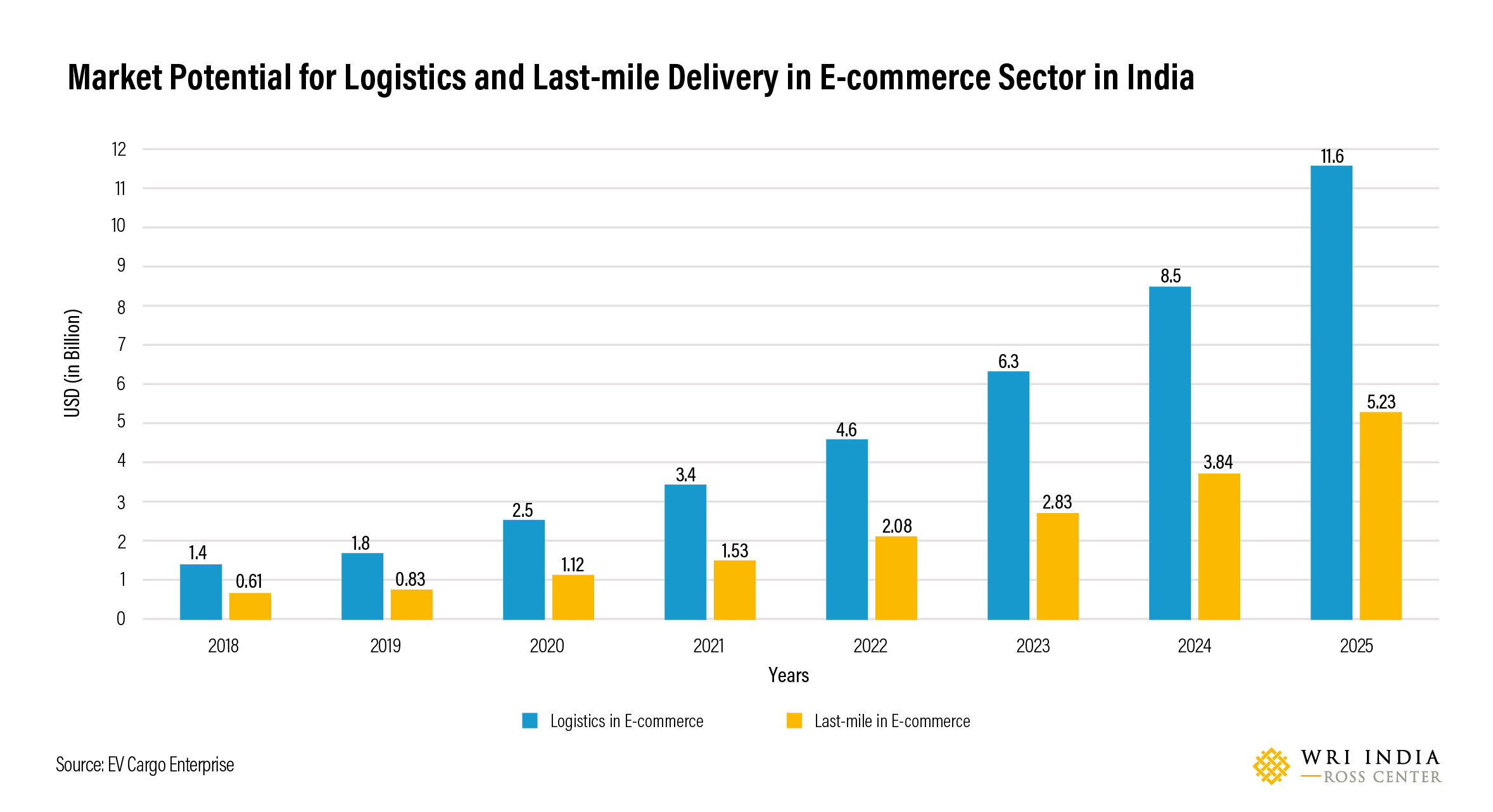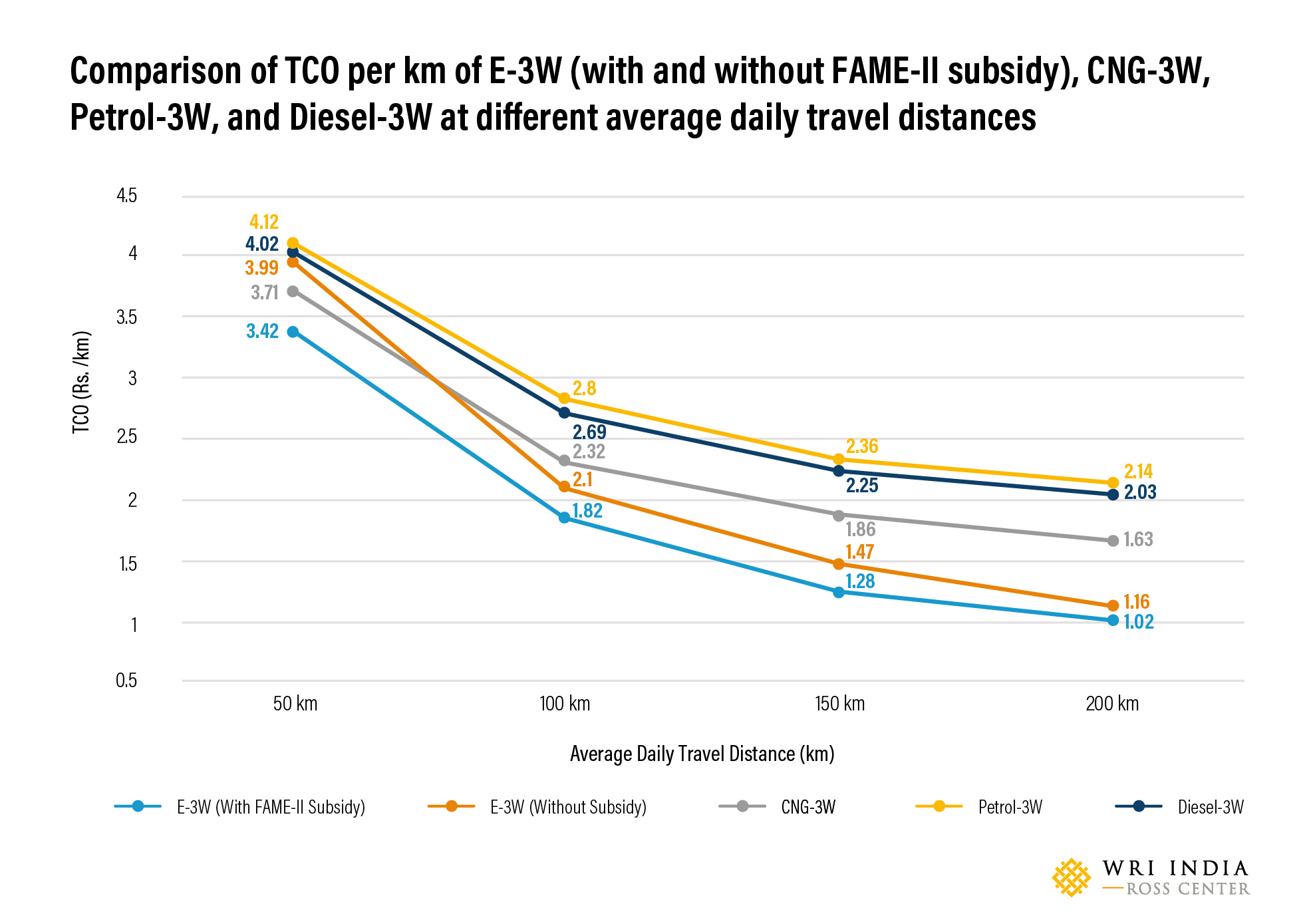
Electrification of 3-Wheeler Cargo Segment in India: Potential & Challenges
In FY2020, the goods carrier segment accounted for 17.5% (1,11,554 units) of the total domestic 3-Wheeler industry sales (6,36,569 units) in India. Since last year, the COVID-19 pandemic-induced restrictions have brought a structural shift in shopping behavior, where an increasing number of customers and businesses are shifting towards e-commerce platforms. For example, Flipkart’s wholesale, a digital B2B marketplace, has seen a 75% month-on-month growth in customer base since September 2020, with one out of five customers from tier 2 or tier 3 cities. In India, the e-commerce industry is estimated to grow by 84% to USD 111 billion by 2024. The logistics in e-commerce is expected to grow from USD 1.4 billion in 2018 to USD 11.6 billion in 2025, while last-mile logistics in e-commerce is anticipated to increase from USD 0.61 billion in 2018 to USD 5.23 in 2025 (see Figure 1). For small loads, 3W goods vehicles are fast becoming a preferred choice for last-mile delivery.

Although the 3W Cargo space is just picking up pace in the Electric Vehicle (EV) industry, it’s believed that these will soon rule the retail business for its high feasibility for small loads, better mileage, and a reasonable yet affordable prices. This blog aims to provide insights into the potential of e-3Ws in the urban freight sector of India.
Policy support for e-3W in the Cargo Segment
The Government of India (GOI), under the FAME (Faster Adoption and Manufacturing of (Hybrid &) Electric Vehicles)-II scheme, is providing a subsidy (INR 10,000 per kWh) to expedite the adoption of EVs, including e-3W in the cargo segment. GOI has allowed the sale of e-2Ws and e-3Ws without batteries to reduce the upfront purchase cost. This step is favourable for battery-swapping, which allows faster re-fuelling, and improves operational efficiency for the vehicles in commercial applications. Further, the new voluntary vehicle scrappage policy will essentially have dual gains of stimulating the domestic automobile industry and removing inefficient, polluting vehicles from the roads. Several state governments have taken various steps to support the electrification of e-3W in the cargo segment. For example, Delhi EV policy 2020 provides incentives to fleet owners to adopt electric goods carriers (e-Carriers) through a purchase incentive of INR 30,000 to the first 10,000 e-Carriers registered, an interest subvention of 5% on loans, and eligibility of e-carriers for a scrapping incentive, and road tax exemption for EVs.
Economic Viability of e-3Ws
High upfront cost of EVs and lack of convenient and affordable charging solutions are among the major barriers in accelerating EV adoption. WRI India’s Total Cost of Ownership (TCO) analysis suggests that the TCO per km of e-3Ws (with and without subsidy) is lower than that of ICE-3Ws for a daily travel distance of close to 100 km. With FAME-II subsidy, the TCO per km of e-3W is lower than the ICE-3W even at a 50 km of average daily travel distance. The gap in TCO per km of e-3W and ICE-3Ws suggests that the e-3W adopters can increase their income via ICE to EV transition.

High vehicle utilization has been found to increase the economic viability of EVs, which implies a significant business opportunity for e-3Ws in commercial applications like last-mile delivery.
E-3W adoption in Cargo segment: Current status and market potential
Currently, e-3W (excluding e-rickshaw) accounts for 14% of total 3W sales in India, and it is estimated to reach 35-45% by 2025 and 65-75% by 2030. In February 2021, e-3W-cargo accounted for 18% of the total e-3W sales in India. Innovative business models and financing options can further help circumvent barriers to the popularity of e-3Ws in the cargo domain. Recently, Etrio launched its e-3W cargo vehicle, Touro, which can be acquired on lease rentals at INR 7,000 per month. Realization of lucrative business opportunities has attracted major players into this segment, including Piaggio, India’s second-largest three-wheeler manufacturer, and Omega Seiki. Even Amazon India and Flipkart announced their partnership with leading EV manufacturers to deploy electric delivery vehicles as part of their target to include 10,000 EVs by 2025 and 25000 EVs by 2030, in their delivery fleets, respectively.
Since the operating cost of EVs is significantly less than that of its Internal Combustion Engine (ICE) counterparts, retrofitting provides an opportunity to replace old ICE-3Ws with e-3Ws, and this can further help India in decarbonisation and decongestion of its roads. In recent times, many start-ups have launched their retrofitment kits, which can help auto-drivers to convert their ICE-auto into an electric one. They can recover the cost of the kit in 12-15 months through their savings on the running costs (70-80% less compared to ICE-3W). It has been estimated that 3-4% of all e-3Ws could be retrofitted by the fiscal year 2025.
Summary and Way Forward
Currently, the last-mile delivery ecosystem growing larger by leaps and bounds, switching to EVs becomes a must to counter environmental concerns due to vehicular emissions. E-3Ws, owing to their low operating and maintenance costs along with zero tail-pipe emissions, make an economically viable and environmentally friendly option for commercial use. Following are some key recommendations:
- Introducing risk-sharing mechanisms among key stakeholders, and innovative financing mechanism along with flexible repayment options to accelerate the adoption of e-3Ws in the cargo segment.
- Development of an efficient network of charging infrastructure including battery swapping, which can offer a fast and safe re-fuelling option for the e-3W in the cargo segment, which is important to facilitate smooth and timely deliveries.
- Availability of safe and certified retro fitment kits to convert ICE-3W cargo to electric, which will encourage existing 3W-cargo owners to opt for retrofitting.
Arya Bhat is an intern with the EV team at WRI India.
Views expressed are the author’s own.